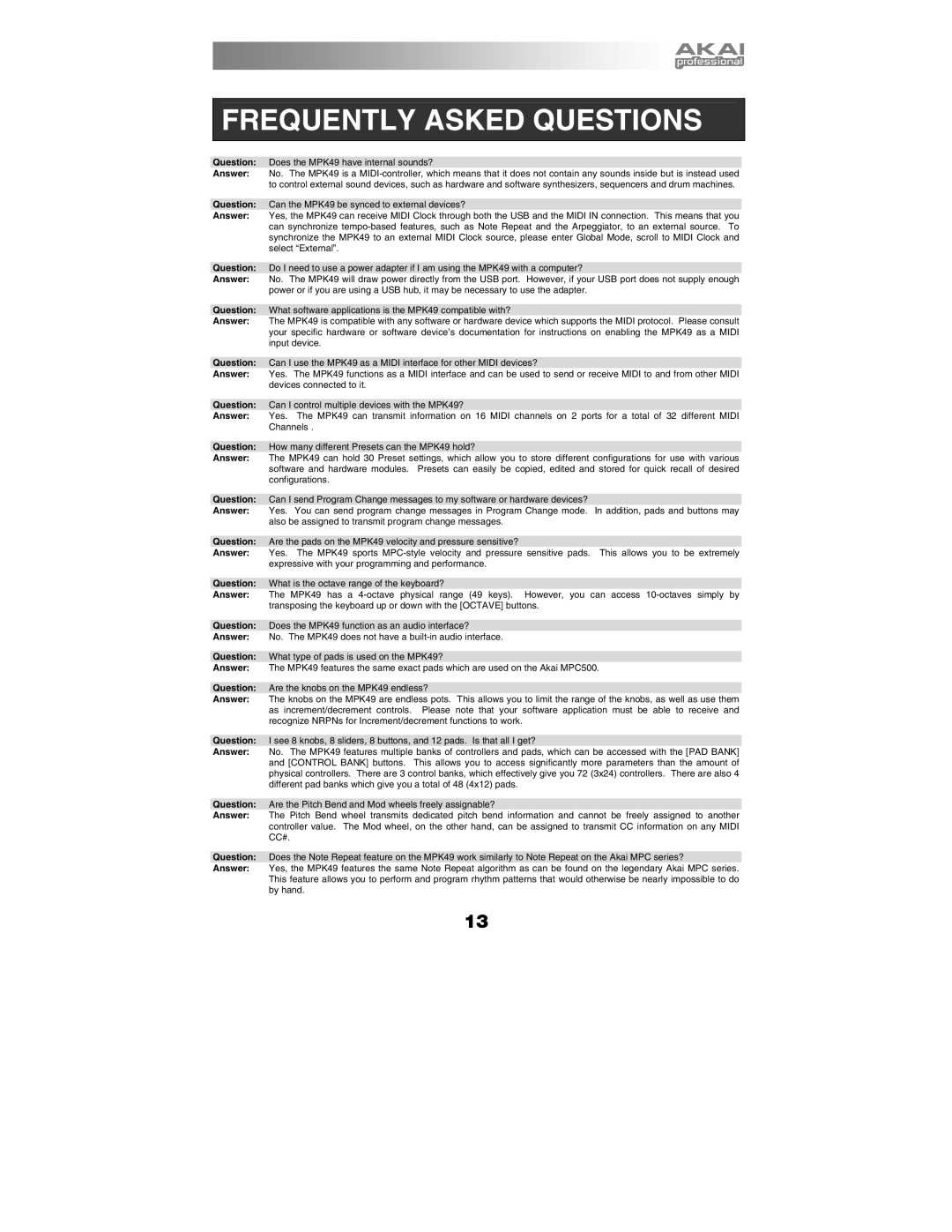
FREQUENTLY ASKED QUESTIONS
Question: Does the MPK49 have internal sounds?
Answer: No. The MPK49 is a
Question: Can the MPK49 be synced to external devices?
Answer: Yes, the MPK49 can receive MIDI Clock through both the USB and the MIDI IN connection. This means that you can synchronize
Question: Do I need to use a power adapter if I am using the MPK49 with a computer?
Answer: No. The MPK49 will draw power directly from the USB port. However, if your USB port does not supply enough power or if you are using a USB hub, it may be necessary to use the adapter.
Question: What software applications is the MPK49 compatible with?
Answer: The MPK49 is compatible with any software or hardware device which supports the MIDI protocol. Please consult your specific hardware or software device’s documentation for instructions on enabling the MPK49 as a MIDI input device.
Question: Can I use the MPK49 as a MIDI interface for other MIDI devices?
Answer: Yes. The MPK49 functions as a MIDI interface and can be used to send or receive MIDI to and from other MIDI devices connected to it.
Question: Can I control multiple devices with the MPK49?
Answer: Yes. The MPK49 can transmit information on 16 MIDI channels on 2 ports for a total of 32 different MIDI Channels .
Question: How many different Presets can the MPK49 hold?
Answer: The MPK49 can hold 30 Preset settings, which allow you to store different configurations for use with various software and hardware modules. Presets can easily be copied, edited and stored for quick recall of desired configurations.
Question: Can I send Program Change messages to my software or hardware devices?
Answer: Yes. You can send program change messages in Program Change mode. In addition, pads and buttons may also be assigned to transmit program change messages.
Question: Are the pads on the MPK49 velocity and pressure sensitive?
Answer: Yes. The MPK49 sports
Question: What is the octave range of the keyboard?
Answer: The MPK49 has a
Question: Does the MPK49 function as an audio interface?
Answer: No. The MPK49 does not have a
Question: What type of pads is used on the MPK49?
Answer: The MPK49 features the same exact pads which are used on the Akai MPC500.
Question: Are the knobs on the MPK49 endless?
Answer: The knobs on the MPK49 are endless pots. This allows you to limit the range of the knobs, as well as use them as increment/decrement controls. Please note that your software application must be able to receive and recognize NRPNs for Increment/decrement functions to work.
Question: I see 8 knobs, 8 sliders, 8 buttons, and 12 pads. Is that all I get?
Answer: No. The MPK49 features multiple banks of controllers and pads, which can be accessed with the [PAD BANK] and [CONTROL BANK] buttons. This allows you to access significantly more parameters than the amount of physical controllers. There are 3 control banks, which effectively give you 72 (3x24) controllers. There are also 4 different pad banks which give you a total of 48 (4x12) pads.
Question: Are the Pitch Bend and Mod wheels freely assignable?
Answer: The Pitch Bend wheel transmits dedicated pitch bend information and cannot be freely assigned to another controller value. The Mod wheel, on the other hand, can be assigned to transmit CC information on any MIDI CC#.
Question: Does the Note Repeat feature on the MPK49 work similarly to Note Repeat on the Akai MPC series?
Answer: Yes, the MPK49 features the same Note Repeat algorithm as can be found on the legendary Akai MPC series. This feature allows you to perform and program rhythm patterns that would otherwise be nearly impossible to do by hand.
13
